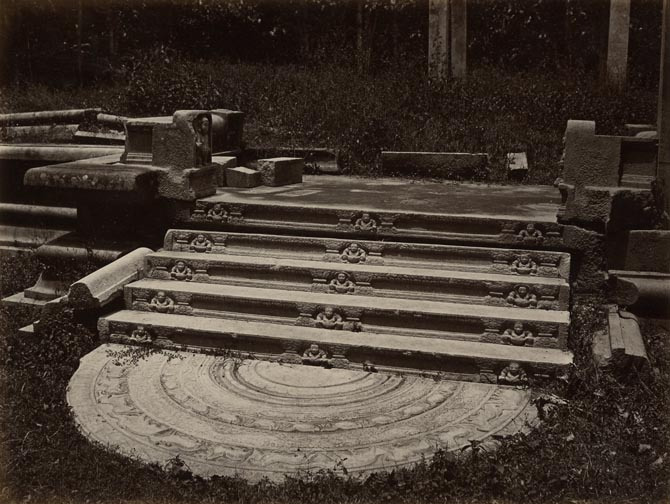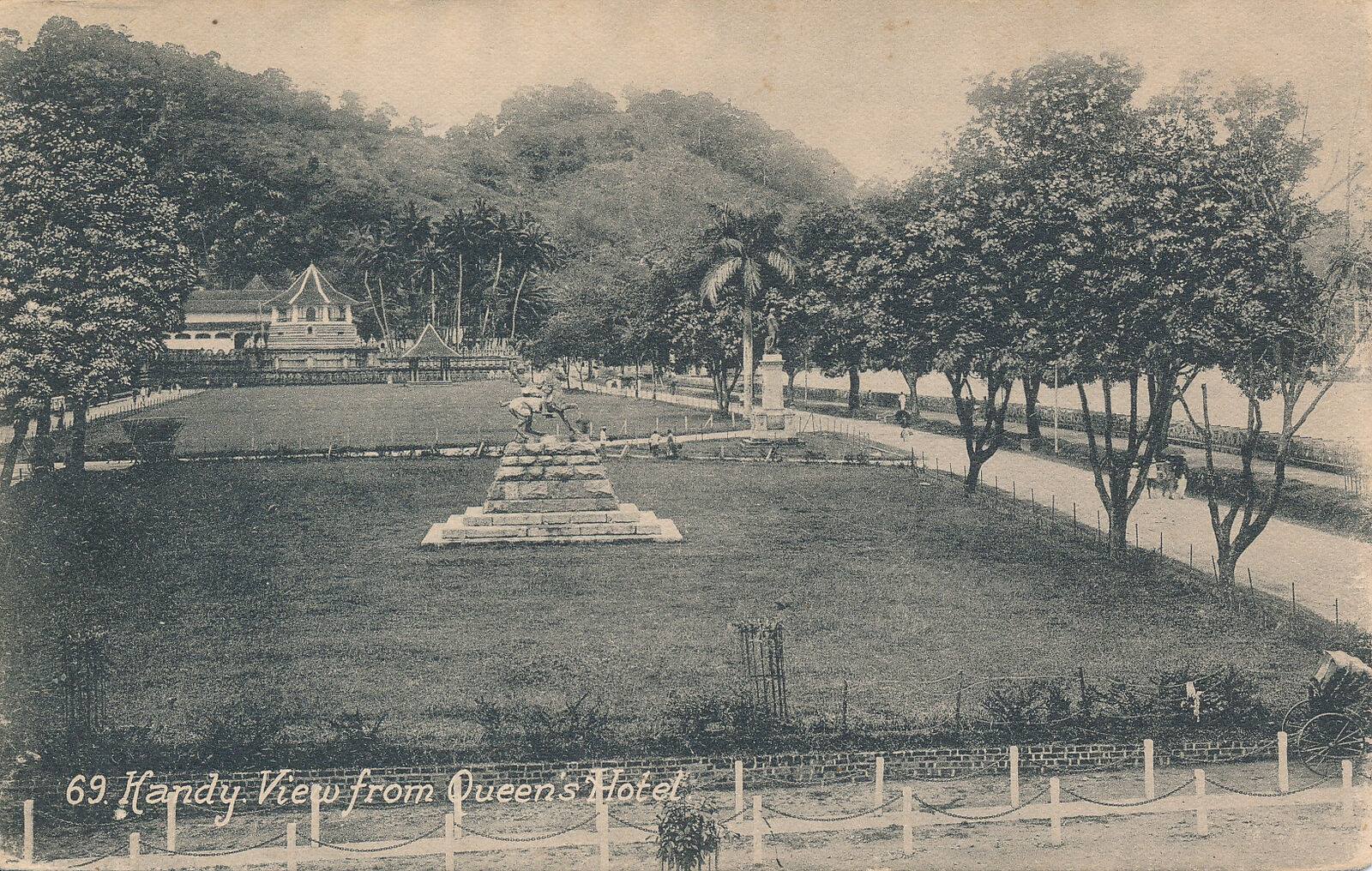Temples, Porticos, Stone Troughs, Cisterns, Bathing tanks
ඔබ කැලෑ අඩි පාරවල් ඔස්සේ හෝ එසේත් නැතිනම් පුරාවිද්යා කැණීම් කටයුතු සඳහා පසුගිය අවුරුදු කිහිපය තුළදී සකස් කරන ලද පාරවල් දෙක තුන දිගේ හෝ කරක් ගහන්නට කැලෑවට යනවා නම්, ඔබට හමු වේවි අනන්ත අප්රමාණ කුඩා කුඩා නෂ්ටාවශේෂ මහා රාශියක්. මේ අතර වැඩිපුරම තියෙන්නේ තවමත් කෙළින් සිටවී ඇති කුළුණු පන්ති සමූහ. එක් පන්තියක 20ක් 30ක් වගේ තිබෙනවා. සමහරක් ඒවා ගලෙන්ම රළුවට කපලා. අනෙක් ඒවා කදිම ලෙස හැඩ කරලා, කුළුණු හිස කැටයම් දාලා.
 |
| Moonstone, Balustrades and Steps, Anuradhapura photographed by Skeen & Co |
සිද්ධස්ථාන, ද්වාර මණ්ඩප, ගල් ඔරු, ජල ටැංකි සහ නාන තටාක
මේවා දැවමය ගොඩනැගිල්ලක යටි මහලේ පාදම හරි, දේව මංගල්යන් පවත්වන පියස්සක් දාරාගෙන හිටපු ගිමන් හලක ද්වාර මණ්ඩපයක් හරි, භික්ෂූණ් සඳහා වූ වාසස්ථානයක් හරි වෙන්න පුළුවන්. ගලින් හෝ ගඩොලින් බැඳි බිත්තියක් සහිත ගොඩනැගිලි ඉතුරුවෙලා තියෙන්නේ බොහොම අඩුවෙන්. ඒත් සැහෙන තරම් අත්තිවාරම් ආකෘති ප්රමාණයක් නම් තාමත් ඉතුරුවෙලා තියනවා. මේවා මහජනයාගේ හෝ පූජ්ය පක්ෂයේ පරිශ්රයන් වෙන්නට පුළුවන්.
 |
| Moonstone, Anuradhapura photographed by Joseph Lawton |
සමහරක් ඒවායේ මනහර ලෙස ඉහළට පිය ගැට පෙළක් සහ ගරාදි වැටක් සේ කොරවක්ගල් දකින්න තියනවා. පහළම පඩියේ නිතරම අඩ සඳක් වගේ ගලින් කැටයම් කරන ලද සඳකඩ පහනක් දකින්න තියනවා. මෙහි බොහොම දර්ශනීය ලෙස අලියන්, සිංහයන්, අශ්වයන්, බ්රහ්ම ගවයන්, පාත්තයන්, සහ නෙළුම් මලක් කැටයම් කොට තියනවා.
 |
| Moonstone and Steps, Anuradhapura photographed by Scowen & Co. |
කටු අකුල් අතරේ තියන මේ ඉහළට විහිදෙන පඩි හයක් ඇති පියගැට පෙළ කොහෙන් ඇවිත් කොහාට යන එකක්ද කියලා කියන්න හැකියාවක් නැහැ.
 |
| Galoruwa - The Stone Canoes photographed by Joseph Lawton [Image Courtesy: www.imagesofceylon.com ] |
මේ දැවැන්ත ගල් ඔරුව අඩි හැට දෙකක් දිගයි, අඩි හතරයි අඟල් හතරක් පළලයි. දැන කියා ගත්තු විදිහට මේවා භික්ෂූණ්ට බත් බෙදන්න පාවිච්චි කරපුවද, රාජකීය අලි ඇත්තුන්ගේ ආහාර දමන්න පාවිච්චි කරපුවාද කියලා සැකයක් තියනවා! මෙහි තියන මේ වගේ ඕනම ජල ටැංකියක් (ගල් ඔරුවක්) අඩි දහයක් දිගයි අඩි පහක් පළලයි. බොහොම කදිමට තනි කලු ගලකින් කපාගෙන සකසා තියනවා.
 |
| Galoruwa - The Stone Canoes photographed by Skeen & Co. [Image Courtesy: www.imagesofceylon.com ] |
ජනප්රවාදයේ කියවෙන්නේ මේවා භික්ෂූණ්ට දන් පිළිගැන්වීමට යොදා ගත් බවක්. මීට අවුරුදු කිහිපයකට පෙර අසල්වැසි ගම් පළාතක් ජූනි මාසේ පුරපෝදාට වන්දනාවේ එන වන්දනාකරුවන් සඳහා මේවා සම්පූර්ණයෙන්ම ආහාරයෙන් පුරවා තිබෙනවා. (එස්. එම්. බරෝව්ස්ගේ ලංකාවේ වැළලුණු නගර - ලන්ඩන්, ටෘබ්නර් සහ සමාගම, 1885*).
 |
| Mihintale. The Bhójana Sáláwa (or Refrectory), showing the two inscribed stones at the entrance. Photographed by Joseph Lawton (d. 1872) [Image Courtesy: http://collections.vam.ac.uk ] |
පැතලි පුවරුමය ඵලක සෑහෙන ප්රමාණයක් මේ අතර දකින්න පුළුවන්. ඒවායේ මුහුණතේ පෞරාණික ශිලාලේඛනයක් දැකගන්න පුළුවන්.
 |
| Steps Leading to the smaller tank of the Kuttam Pokuna photographed by Joseph Lawton [Image Courtesy: www.imagesofceylon.com ] |
සෑම දිසාවකම වගේ තද ගලින්ම කරන ලද පිහිනුම් තටාක තියනවා. මේවා දිගින් යාර 10ක්, 20ක්, 30ක් ඉඳන් (එක්තරා අවස්ථාවක) යාර 100ක් තරම් දිගු වෙනවා. කුට්ටම් පොකුණු (නිවුන් සහෝදර පොකුණු) ලෙසින් ප්රසිද්ධ මේ වගේ පොකුණු දෙකක්, උතුරු වටරවුම් මාර්ගය අසල තාමත් හොඳට සංරක්ෂණය වී තියෙනවා. දක්වා ඇති කුට්ටම් පොකුණු ඡායාරූපයේ ඇති එක් තටාකයක් යාර 44ක් දිගයි. අනෙක යාර 30ක් දිගයි. දෙකටම මනහර පියගැට පෙළ දෙකක් දෙපසින් ජල මට්ටමට පහත් වෙනවා. තටාකය වටේම පඩි ලෙස බෑවුම් වූ ස්ථර කිහිපයක් දකින්න තියනවා. මේ පොකුණු වලට ඉහළින් කිසිම ආවරණයක් නැහැ. හිරුට සහ අවට අවකාශයට විවෘතයි.
 |
| Ruins of the Bathing Pool, Anuradhapura photographed by Skeen & Co. [Image Courtesy: http://www.imagesofceylon.com ] |
[
අනුවාදක සටහන :
*- එස්. එම්. බරොව්ස් (ශ්රීමත් ස්ටෙෆාන් මොන්ටිගු බරොව්ස්)
 |
| Sir (Stephen) Montagu Burrows - 1933 (© National Portrait Gallery, London) |
“ආදම්ගේ ශිඛරය මතින් එලිෆන්ටා ගුහා වෙත – ලක්දිව සහ ඉන්දියාවේ රූප සටහන්” : එඩ්වඩ් කාපෙන්ටර්
සයවන පරිච්ඡේදය : අනුරාධපුරය, වන අරණේ නටබුන් නගරය.
From Adam’s Peak To Elephanta : Sketches in Ceylon and India by Edward Carpenter
CHAPTER VI: ANURADHAPURA – A RUINED CITY OF THE JUNGLE.
As you roam through the woods by jungle paths, or along the two or three roads which have been made in late years to open up the ruins, you come upon innumerable smaller remains. Most frequent among these are groups of columns still standing, twenty or thirty together, sometimes only roughhewn, sometimes elegantly shaped, with carven capitals, which either formed the foundation storeys of wooden buildings, or being themselves covered with roofs constituted porticos for the resting-places of the gods in their processions, or habitations for the use of the priests. There are very few remains of walled buildings, stone or brick, but plentiful foundation outlines of what may have been public or sacred enclosures of one kind or another—some with handsome flights of steps and balustrades leading up to them, and for the lowest step the frequent half-moon stone carved with elegant devices of the elephant, the lion, the horse, the brahman bull, the goose, and the lotus-flower. Here among the tangle is a flight of half-a-dozen steps, springing from nowhere and apparently leading nowhither. There is a gigantic stone trough, sixty-two feet long by four feet four inches wide, over which the learned are in doubt whether it was used to contain food for the royal elephants or boiled rice for the priests ! Here at any rate is a cistern ten feet long by five wide, elegantly carved out of a single block of granite, which, tradition says, served for the priests' rice-dish ; and which only a few years ago was, by the subscription of a neighboring country side, filled full of food (see S. M. Burrows' Buried Cities of Ceylon ; London, Trubner & Co., 1885) for the pilgrims of the June full moon. There again is one of the numerous flat slabs which may be found, bearing an ancient Inscription on its face ; and in almost every direction are solid stone swimming baths or tanks, ten, twenty, or thirty yards up to (in one case) fully 100 yards in length. Two of these pokunas, so-called—the twin pokunas—stand near the northern circular road, and are still in good preservation ; the one given in the illustration on next page is forty-four yards long, the other about thirty, and both have handsome flights of steps at each end by which to descend to the water, and step-like tiers of stonework round the sides. They were of course not covered, but open to the sun and air.
ලක්දිව ගමන් සටහන් පිටු අංක: 44




Comments
Post a Comment